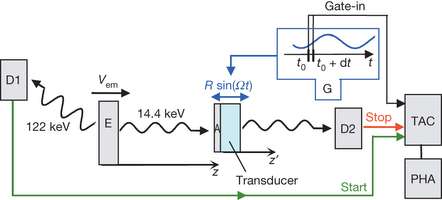March 17, 2014 report
Research team devises a way to create pulses of gamma rays with precise shape and timing

(Phys.org) —A team of researchers based at Texas A&M University with affiliations with several Russian Universities has come up with a way to create pulses of gamma rays that have precise shapes and timing, all from a single photon source. In their paper published in the journal Nature, the team describes how they used cobalt to produce coherent single photon pulses.
Gamma rays have quite a bit more energy than regular light, and their wavelength is a lot shorter too—both attributes that could make them an ideal candidate for better data communications and other physics applications. Unfortunately, they are not as easy to produce and harness as regular light. In this new effort, the researchers looked to radioactive Cobalt as a possible solution.
Normally, cobalt-57 releases pairs of photons one after the other as it decays to iron-57—the waveforms of the photons spread across time and exponentially decay. As part of their experiment, the researchers instead caused a photon to be absorbed into the nucleus of an iron atom using a sheet of steel foil, which also allowed for detection of the photon as it was later released. By vibrating the foil, the researchers found they were able to cause the photons to be absorbed at different distances from the source. This meant the reemergence of the photon as it was released could be caused to take different amounts of time to strike the detector. By changing the vibration frequency, the team found they were able to adjust the amount of time it would take the photon to strike the detector.
The result of the experiment was that the researchers discovered that they were able to use the vibrating motion of the foil to create a wave form as a series of fading, coherent pulses that were all evenly spaced apart. By adjusting the vibration characteristics, the researchers found they could fine tune the number, duration and shape of the pulses—they could even produce pairs if desired. Put another way, the researchers efforts have resulted in a method for both producing and harnessing the energy in gamma rays.
Possible uses for such technology range from improving spectroscopy devices, to new quantum cryptography techniques to increased high-speed data communications.
More information: Coherent control of the waveforms of recoilless γ-ray photons, Nature (2014) DOI: 10.1038/nature13018
Abstract
The concepts and ideas of coherent, nonlinear and quantum optics have been extended to photon energies in the range of 10–100 kiloelectronvolts, corresponding to soft γ-ray radiation (the term used when the radiation is produced in nuclear transitions) or, equivalently, hard X-ray radiation (the term used when the radiation is produced by electron motion). The recent experimental achievements in this energy range include the demonstration of parametric down-conversion in the Langevin regime1, electromagnetically induced transparency in a cavity2, the collective Lamb shift3, vacuum-assisted generation of atomic coherences4 and single-photon revival in nuclear absorbing multilayer structures5. Also, realization of single-photon coherent storage6 and stimulated Raman adiabatic passage7 were recently proposed in this regime. More related work is discussed in a recent review8. However, the number of tools for the coherent manipulation of interactions between γ-ray photons and nuclear ensembles remains limited. Here we suggest and implement an efficient method to control the waveforms of γ-ray photons coherently. In particular, we demonstrate the conversion of individual recoilless γ-ray photons into a coherent, ultrashort pulse train and into a double pulse. Our method is based on the resonant interaction of γ-ray photons with an ensemble of nuclei with a resonant transition frequency that is periodically modulated in time. The frequency modulation, which is achieved by a uniform vibration of the resonant absorber, owing to the Doppler effect, renders resonant absorption and dispersion both time dependent, allowing us to shape the waveforms of the incident γ-ray photons. We expect that this technique will lead to advances in the emerging fields of coherent and quantum γ-ray photon optics, providing a basis for the realization of γ-ray-photon/nuclear-ensemble interfaces and quantum interference effects at nuclear γ-ray transitions.
Journal information: Nature
© 2014 Phys.org



















